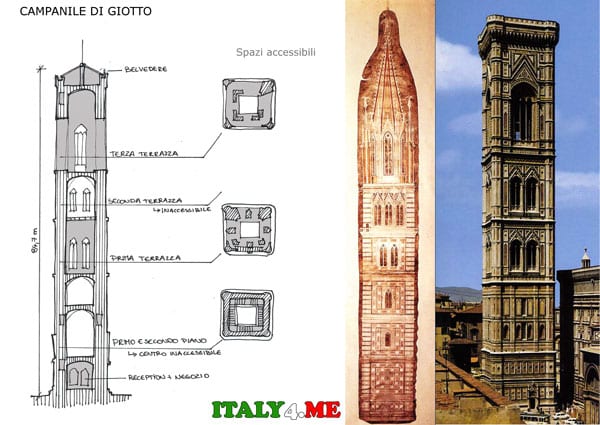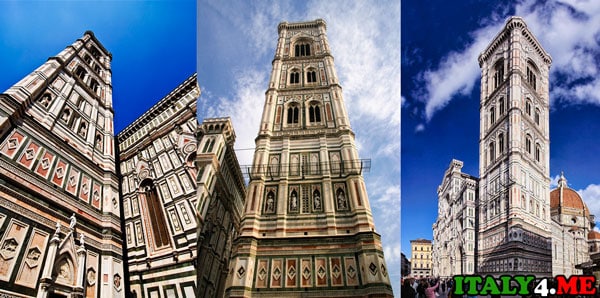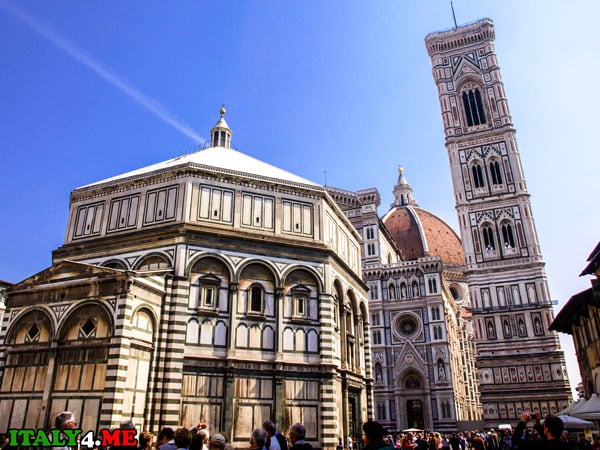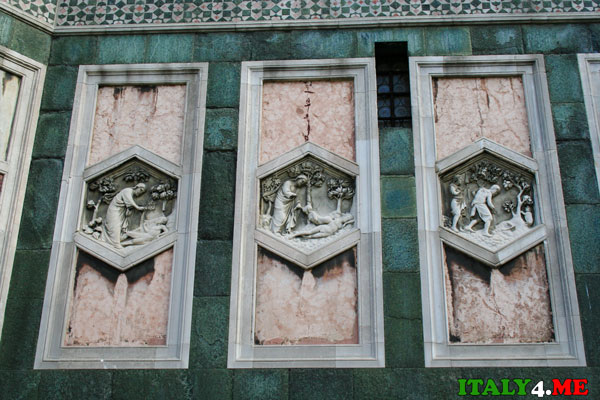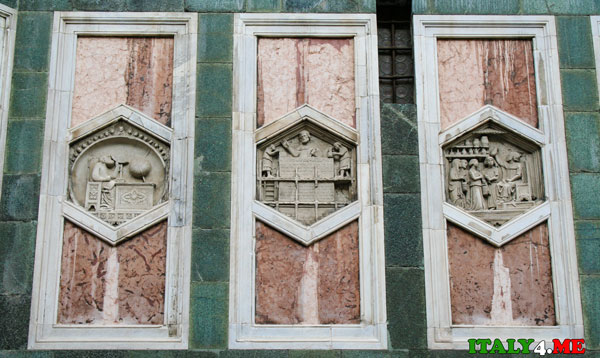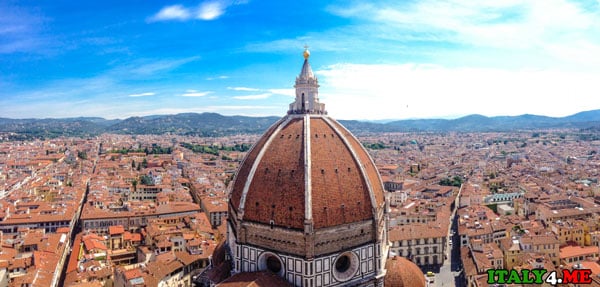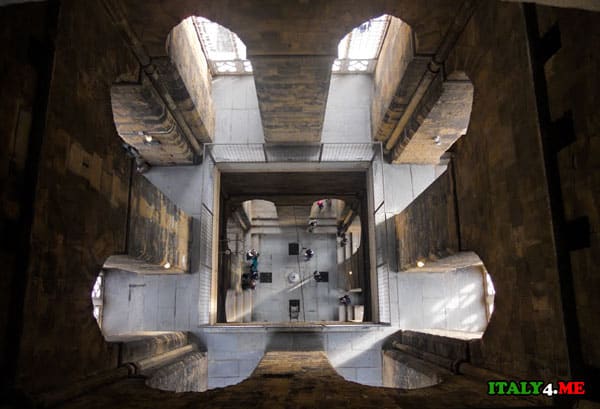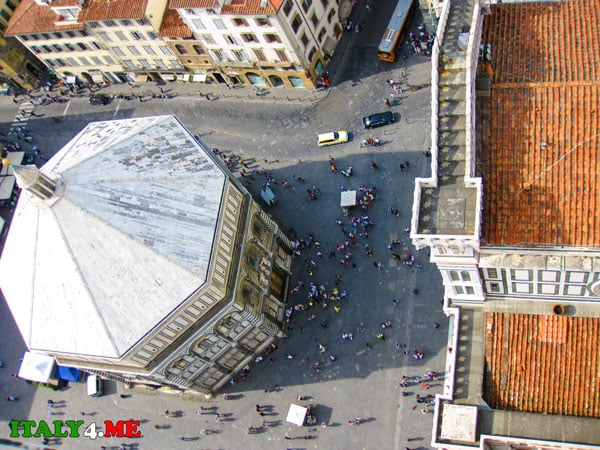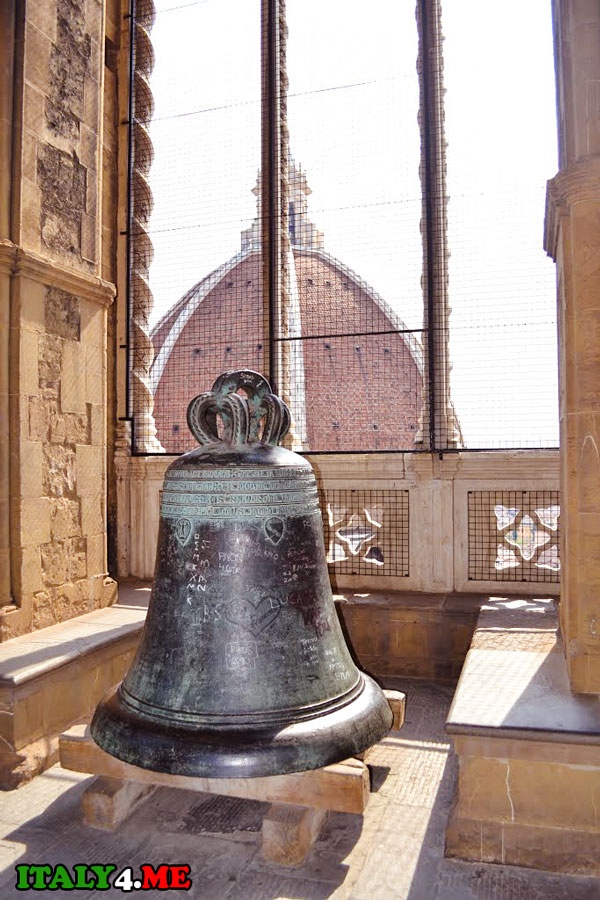In the heart of Italian Florence, travelers can admire the most extraordinary cathedral in all of Europe – Santa Maria del Fiore. We have already talked about the charms of the cathedral itself. Now, it is worth paying your attention to another majestic building that is part of the Florentine Duomo complex – Giotto’s bell tower.
Soaring almost 90 meters high, this bell tower allows visitors to enjoy a gorgeous panorama of the city and its surroundings. It is simply impossible to be indifferent to such an attraction.
When the cathedral was being built, the only effective way to notify the city’s inhabitants about the upcoming church festivities and services was the ringing of bells. Therefore, the author of the original project of the cathedral, Arnolfo di Cambio, added a campanile tower to it. Giotto di Bondone contributed to the development of the building plan and the construction of the first tier of the bell tower. Grateful descendants immortalized the name of the great master, calling the tower the Giotto bell tower (Italian: Campanile di Giotto).
Page Contents
The history of the construction of the bell tower by Giotto
If you face the main entrance to the Cathedral of Santa Maria del Fiore, the campanile building will be on your right hand. The building and construction works started at the end of the 13th century. In fact, the builders worked simultaneously on the footing of the cathedral building and the campanile. At that time, the works took place under the vigilant supervision of the first architect of the cathedral – Arnolfo di Cambio.
After di Cambio’s death, construction ceased for as much as 30 years. Only in July 1334 Giotto di Bondone re-launched the construction project of a monumental Catholic church.
The pits for the foundation of the bell tower, which went 20 cubits deep, were all that the new architect had at his disposal.
According to medieval trends, the bell tower was conceived as a four-sided tower with a side of 25 cubits and a height of 144 cubits. Giotto did not change anything in the overall project, focusing on sketching for the exterior and interior design.
The intense work on the construction of the bell tower completely captured the attention of the architect and artist. Giotto seeks to improve di Cambio’s design by adding an additional superstructure on top of the tower. However, conservatively minded construction curators decided not to use the new project as too bold.
Giotto’s age was steadily approaching 70, which at that time was a fairly decent figure. Having worked on the campaign for only 4 years, the master dies, leaving behind a decent amount of developments and a finished first tier.
To decorate the campanile, Giotto used the same multi-colored marble used to decorate the Cathedral of Santa Maria del Fiore. The hay belfries were decorated with panels according to the author’s sketches. Red and white contrasting patterns add incredible depth to the patterns. Subsequently, the exterior decor of the bell tower was made in the workshop of the famous genius of the Italian Quattrocento – Luca della Robia, the sculptor.
The work of the deceased Giotto was continued by the architect Andrea Pisano, who was actively involved in engineering work during Giotto’s lifetime. Having received the post of chief curator of the construction of the campanile, Pisano managed to erect two subsequent tiers of the building. The construction and decoration of the tower were conducted in strict accordance with Giotto’s vision. Unfortunately, the plague epidemic that broke out in the middle of the 14th century took many lives, including Andrea Pisano’s. As a result, the construction works of the cathedral and the bell tower freeze again for several years.
Giotto’s bell tower received the third creator in 1351 – Francesco Talenti. Thanks to the talented architect, the Florentines got a slender campanile building. The first three tiers of the building look more “chunky.” In contrast to them, the three upper floors, created by Talenti, turned out to be elongated upwards. Narrow windows, decorated with vertical decor, enhance the impression of gothic lancet and aspiration to the sky.
Talenti did his best at the tower to get a rich modern finish. Another difference from the original design is the flattened roof. The completion of work on the bell tower dates back to 1359. The tricolor marble finish of the tower united its appearance with that of the cathedral. The final height of the building was 85 meters. The spire, abolished by Francesco Talenti, assumed an additional 37 meters of “growth.”
The exterior design of Giotto’s bell tower
As we mentioned earlier, the lower tiers of the belfry look more stocky. They are richly decorated with carved tiles and bas-reliefs. Work on the first tier is the merit of Giotto. Against the background of gray-green marble, the architect ordered to place vertical paintings of pink marble in a white edging. In the center of each tile, there are medallions illustrating the seven sacraments and scenes from the Bible. Each of the four walls of the tower is decorated with seven such slab paintings.
The next tiers of the campanile are decorated with bas-reliefs created by Luca della Robia and Andrea Pisano. Talented artists showed in their works the complex path of human progress. The bas-reliefs illustrate the genesis of man and then his knowledge of crafts, science, and culture. Professions quite typical for the Middle Ages are depicted: a winemaker, an astronomer, a stonecutter, a shepherd, etc. Worldly affairs are diluted with a whole collection of virtues.
One of the tiers is devoid of decorative bas-reliefs. Four slabs are with empty frames. The fourth tier of the tower lost its decorations – sculptures that embodied the biblical prophets in stone. The works of the architects Nino Pisano, Donatello, Andrea Pisano, and Nanni di Bartolo were handed over to the Duomo Museum, where they are guaranteed to be preserved.
Above the entrance to the bell tower one will see Madonna and Child. This work, like most of the decorative elements of the tower, was conceived and realized by Andrea Pisano.
The tiers of the bell tower have a clear horizontal division due to mosaic inserts created by the Kosmati brothers-artists. The top three floors of the tower have elongated windows in lancet frames. Outside, these windows are decorated with stucco, reminiscent of a twisted cord, which gives the building an extra elegance. The lightness of the lines and the openwork of the outer finish turn the campanile into something airy, nullifying the heavy stone and enormous height.
By the way, in the museum at the cathedral, you can see a drawing made by Giotto depicting the general view of the bell tower. The current building looks much more exciting and elegant than planned. However, the tower bears the name of the artist and architect who spent the last years of his life on its creation.
Giotto’s bell tower nowadays
Nowadays, tourists can walk along Cathedral Square, enjoying the perfect beauty of the buildings that make up the Duomo. The bell tower itself is an excellent example of Gothic architecture. Decorated with red, white, and green marble slabs, the tower serves as an observation tower. At almost a hundred meters height, a magnificent view of the red-brown roofs of houses and the broken line of hills on the horizon opens up.
More than 400 steps forming an internal staircase await for visitors. Slowly overcoming the six tiers of the tower on foot, tourists can look at Florence from different angles and heights.
Narrow windows surround the inner staircase of the bell tower from top to bottom. On the observation deck, in addition to the distant borders of the city, you can see in detail the dome of Brunneleschi, crowning the cathedral. And also, if you look down, you will see the Baptistery of St. John the Baptist.
“What is the bell tower without a bell?” – you ask, and you will be absolutely right! The bell is on the top floor of the tower. True, it does not fulfill its primary function but is exhibited in one of the niches as a museum exhibit.
Visitors are allowed to wander through all the tiers, including the top one, where you can see the roof rafters and even the tiling.
The point of all the aspirations of the guests of the city is the observation gallery, organized around the perimeter of the roof of Giotto’s bell tower. For the convenience of visitors, the gallery is equipped with binoculars.
Helpful information: how to get there
Campanile is easy to find in the center of Florence on Cathedral Square, next to the Cathedral of Santa Maria del Fiore.
Find a hotel near Giotto’s bell towerYou can visit the observation gallery from 8:30 a.m. to 7:30 p.m. The bell tower is closed for visitors on major religious holidays, such as Easter, Christmas, and the Day of the Virgin Mother.
A single ticket to the tower costs 6 EUR. Tickets can be purchased on the spot or booked at the official website www.museumflorence.com. It’s more reasonable to buy a ticket for 10 EUR, which includes access to other attractions:
- Dome
- Baptistery
- Campanile Giotto
- Crypt of Saint Reparat
- Historical Museum
 Italy for me From Italy with love
Italy for me From Italy with love


